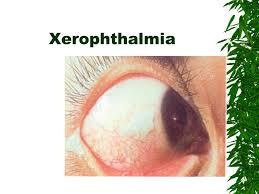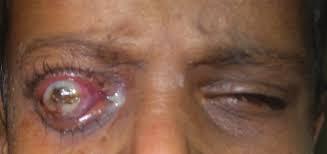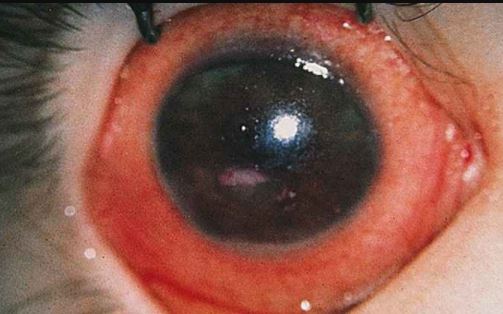Xerophthalmia
What is Xerophthalmia?
Xerophthalmia is a condition affecting the eye balls in which case the tear ducts produce little to no tears and may cause night blindness or complete blindness in some cases. It could be due to vitamin A deficiency, but there are other causes such as aging. Tears are generally very important to our vision and if the eye fails to be provided with a certain amount of tears, it may cause irritation, dryness, stinging pain, and may even cause blurred vision.


Tear production is reflex and the eye renews the layer naturally every time we blink. It is however important to keep in mind that tears are sometimes produced as a response to external stimuli, but these tears do very little for people with xerophthalmia and hence they may still experience irritation despite this. 1,4
If the condition is caused by deficiency of vitamin C, there is normally an acute dryness of the conjunctiva. It becomes thick and wrinkled. It may eventually lead to corneal ulceration and later to blindness due to damage to the cornea, if left untreated. The condition is very common in under developed countries and rare in the developed ones. There are other forms of dry eye and these tend to be associated with things like aging, poor lid closure, autoimmune diseases, and scarring from previous injuries
When it comes to xerophthalmia, the damage to the cornea is quite different from the damage to the retina, which is at the back of the eye, but both may be due to vitamin A deficiency.
Causes of Xerophthalmia
Did you know that in developing countries xerophthalmia accounts for 20,000-100,000 of the cases of childhood blindness? The disease affects children under 9 years mostly. It is not, however, congenital and develops gradually over a couple of months as the tear ducts slowly stop producing tears.
The main causal factor of the condition is deficiency in Vitamin A. Another common cause of the condition is aging. As we continue to age, our bodies produce less lipid substances and this is more prominent in females than males as their skin start to dry quicker than in men. This lack of oil affects the lipid layer and it is unable to cover the other layers sufficiently causing them to evaporate quickly and leave some areas dry.
Other causes of xerophthalmia include:
- Heat dryness in the atmosphere and wind
- High altitude
- Cigarette smoking
- Long term use of contact lenses
- Certain medicines
- Thyroid problems
- Certain diseases such as lupus erythematosus
- Hormonal changes in women such as menopause
- After suffering a stroke.1,3
Symptoms & Signs

A patient with this condition may show one or more of the following signs and symptoms:
- The appearance of spots in the eye
- Night blindness, which comes before aggravating to corneal ulceration and then to complete blindness
- Foreign object sensation, itching and burning sensation
- The cornea might present with small lesions like point scrapes
- Blurry vision that improves with blinking
- Difficulty in wearing contact lenses
- Lacrimation
- Intense eye irritation from smoke or wind
- Where there is complete lack of tears, there may be incidents of corneal melt or an infection may occur.1,3
Diagnosis of Xerophthalmia
The Schirmer’s test is used to diagnose the condition. In a normal eye, dry spots occur within 15-30 seconds after blinking. In cases where the patient has xerophthalmia, the dry spots will start to occur within 10 seconds. In this test, a paper is placed inside the eye for some time to check the tear production.6
Complications of Xerophthalmia
The condition affects the tear ducts and makes them produce a little less tears than they are supposed to and this, in turn, makes it very difficult to see and causes blurry vision. This will normally start small and develop overtime gradually to things like night blindness, which then becomes corneal ulceration – and slowly by slowly leads to complete and total blindness if not treated as soon as possible.
The condition has also been seen to cause spots, which are clusters of keratin debris building up inside a patient’s conjunctiva. The spots are oval, triangular or irregular in shape.
Treatment of Xerophthalmia
The treatment of the condition is aimed at eliminating the vitamin deficiency or treating the symptoms.
Eye drops and ointments
The treatment of the signs is mostly by use of eye drops and ointments, which are made to mimic tears to ease the discomfort.
Use of caps
In more serious situations, an ophthalmologist may insert certain caps in the lacrimal punctum to prevent the drainage of tears from the eyes completely. The caps may either temporarily dissolve into the eye or need to be applied again or be permanent.
Soft contact lenses
There also are soft contacts, which are issued to patients that help keep moisture, but if the eyelids do not close during sleep a pair of wrap-around glasses is issued as well.
Use of vitamin A supplements
The immediate treatment for the condition, which is a treatment to the deficiency would definitely be vitamin A supplementation. It can either be injected or administered orally depending on age and health condition.
Use of antibiotics
In severe cases antibiotics are given to prevent infections.2,3
Others ways to help treat the symptoms include:
- People who suffer from this condition should generally just avoid dust exposure, smoking, pollen and other pollutants.
- They should also avoid staying in places that have very high temperatures as this will worsen the irritations to the eye.
- Habits such as drinking more water, blinking a lot on purpose when watching TV and of course avoiding excessive eye rubbing are advised.
Prevention of Xerophthalmia
The basic prevention measures include:
- Training should be conducted in most of the developing countries to the medical stuff pertaining to the issue surrounding xerophthalmia cases and how to prevent it.
- Mothers who are pregnant should be advised to take supplements to build up and store retinol in the fetal liver and should be contained during lactation. The ones with winning babies should be advised to give them food rich in vitamin A1,5
The guideline for issuing of supplements for children has been given by the World Health Organization as shown below:
- For infants aged 6 to 12 months and kids above this age but who weigh not more than 8 kg should get oral supplements of vitamin A in every 3 to 6 months
- Children who are aged over 1 year but under 6 years should have oral supplement of vitamin A every 6 months
- Infants not more than 6 months old and who are being breast fed should be given oral supplement of vitamins before attaining 6 months.
Home Remedies for Xerophthalmia
A simple way to help prevent and manage xerophthalmia is to eat fruits and vegetables because they contain vitamins essential for the body and vision. Vitamin A is readily found in animal products such as poultry, fish liver, eggs, meat and dairy products. It is also present in vegetables in the form of beta carotenes, which are changed to retinol in the digestive system. These sources are green leafy vegetables, yellow and orange fruits and vegetables and red palm oil.2
Reference List
- Xerophthalmia. https://en.wikipedia.org/wiki/Xerophthalmia
- http://www.healthline.com/health/eye-health/xerophthalmia#sources-of-vitamin-a4
- http://www.eyeclinic.com.gr/en/suxnes-erwtiseis/item/10-ksirofthalmia.html
- https://www.merriam-webster.com/dictionary/xerophthalmia
- http://www.biologydiscussion.com/diseases-2/xerophthalmia/xerophthalmia-features-treatment-and-prevention/44323
- Xerophthalmia. http://www.targetwoman.com/articles/xerophthalmia.html






